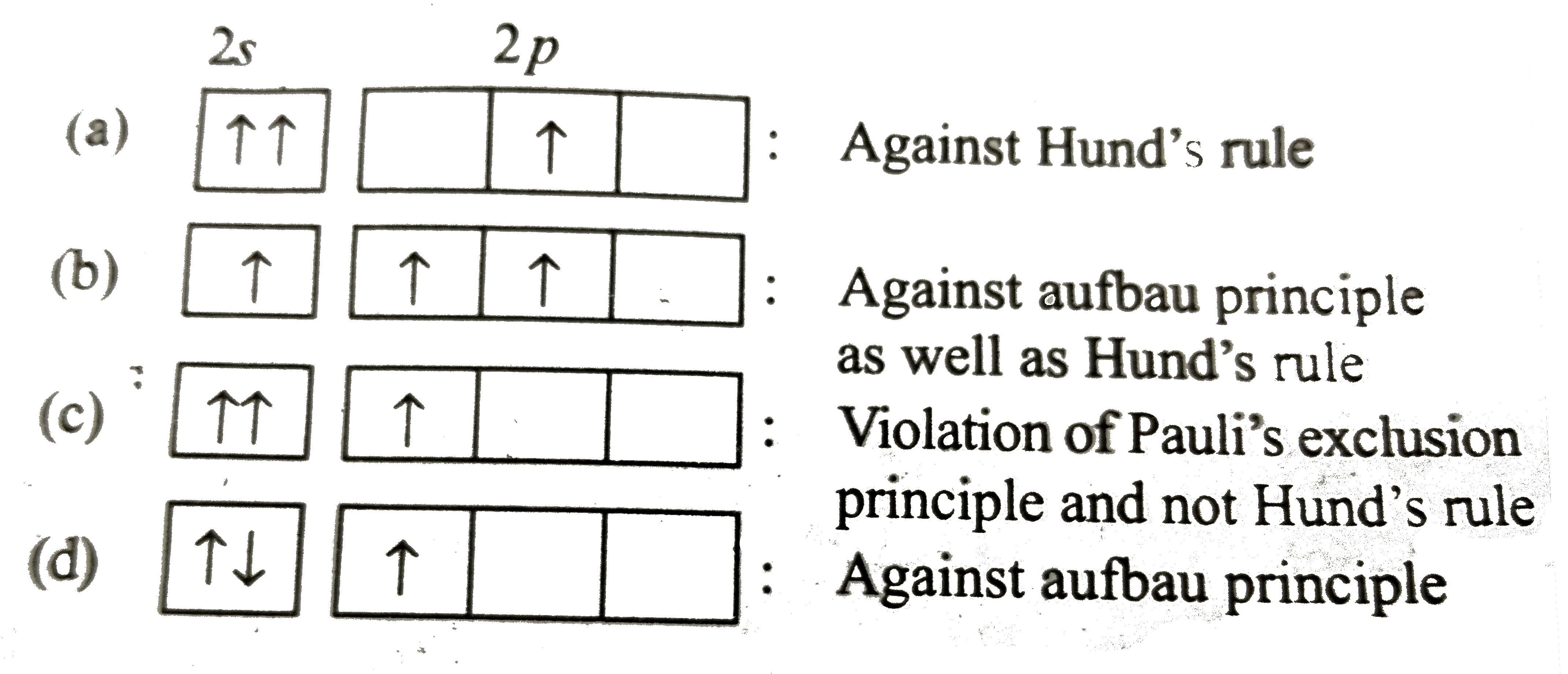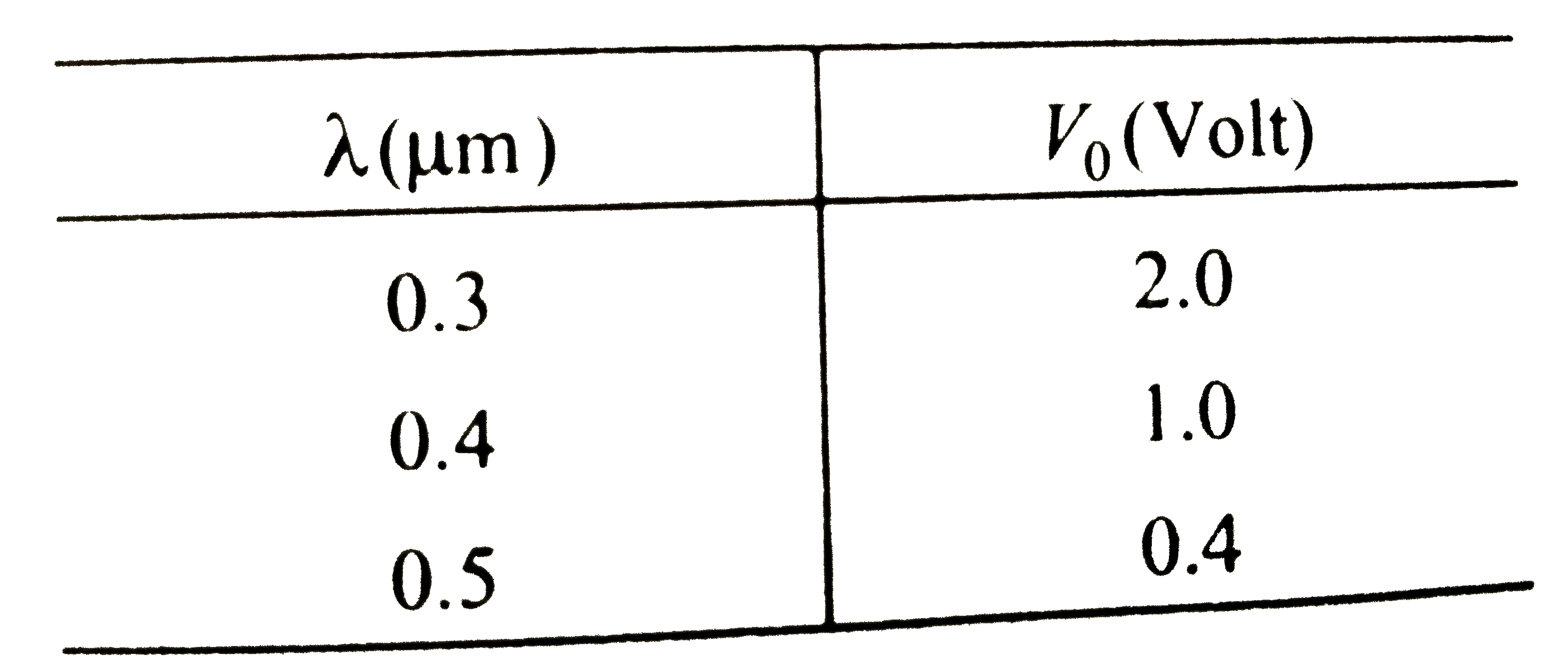Complete Solutions to Objective Question Level-B of chapter ATOMIC STRUCTURE of Class 11 book with complete answers and questions
| Class 11 | CHEMISTRY |
| Chapter | ATOMIC STRUCTURE |
| OP TANDON | Objective Question Level-B |
| Number Of Questions | 51 |
| Academic Year | 2023-24 |
The configuration of Cr atom is `3d^(5)4s^(1)` but not `3d^(4)4s^(2)` due to reason `R_(1)` and the configuration of Cu atom is `3d^(10)4s^(1)` but not `3d^(9)4s^(2)` due to reason `R_(2).R_(1) and R_(2)` are:
View SolutionWhich of the following graphs is incorrect?
View SolutionWhich among the following is correct of `._(5)B` in normal state?

View SolutionMaximum value `(n+l+m)` for unpaired electrons in second excited state of chlorine `._(17)Cl` is:
View SolutionWhich of the following is correctly matched?
View SolutionIn Bohr series of lines of hydrogen spectrum, third line from the red end corresponds to which one of the following inner orbit jumps of electron for Bohr orbit in atom in hydrogen :
View SolutionIn which of the following pairs is the probability of finding the electron in xy-plane zero both orbitals?
View SolutionThe orbital diagram in which both the Pauli's exlusion principle and Hund's rule violated is
View SolutionThe distance between 3rd and 2nd bohr orbits of hydrogen atom:
View SolutionWhich diagram best represnts the apperance of the line spectrum of atomic hydorgen in the visible region?
`overset(Increasing lambda)rarr`
View SolutionThe 'm' vlaue for an electron in an atom is equal to the number of m values for l=1. the electron may be present in
View SolutionFor a sub-shell with azimuthal quantum number 'l', the total values of magnetic quantum number m can be related to l as
View SolutionWhat are the values of the orbital angular momentum of an electron in the orbitals `1s,3s,3d` and `2p`:-
(a). `0,0sqrt(6h),sqrt(2h)`
(b). `1,1sqrt(4h),sqrt(2h)`
(c). `0,1sqrt(6h),sqrt(3h)`
(d). `0,0sqrt(20h),sqrt(6)`
View SolutionAfter np orbitals are filled, the next orbital filled will be :-
(a). `(n+1)s`
(b). `(n+2)p`
(c). `(n+1)d`
(d). `(n+2)s`
View SolutionThe ratio of `(E_(2) - E_(1))` to `(E_(4) - E_(3))` for `He^(+)` ion is approximately equal to (where `E_(n)` is the energy of nth orbit ):
View SolutionWhich of the following electronic configurations has zero spin multiplicity?
View SolutionThe energy required for removal of electron fro 3s,3p,3d subshells of hydrogen atom will lie in followig sequence:
`E_(1)=(3stoinfty)" "E_(2)=(3ptoinfty)" "E_(3)=(3dtoinfty)`
View SolutionWhich of the following electronic configuration have the highest exchange energy?
_S01_107_O01.png)
_S01_107_O02.png)
_S01_107_O03.png)
_S01_107_O04.png)
View SolutionIn a historical experiment to dtermine Planck's constant, a metal surface was irradiated with light of different wavelengths. The emitted photoelectron energies were measured by applying a stopping potential. The relevant data for wavelength `(lamda)` of incident light and the corresponding stopping potential `(V_(0))` are given below

Given that `c=3xx10^(8)ms^(-1)` and `e=1.6xx10^(-19)C`, Planck's constant (in units of J s) found from such an experiment is:
View SolutionAngular distribution functions of all orbitals have:
View SolutionIf uncertainty in position and momentum are equal then uncertainty in velocity is.
View SolutionThe minimum number of waves made by an electron moving in an orbit having maximum magnetic quantum number `+3` is.
View SolutionThe number of elliptical orbits excluding circular orbits in the N-shell of an atom is:
View SolutionFrom the electronic configuration of the given elements K,L, M and N, which one has the highest ionization potential?
View SolutionRadiation of wavelength `lambda` in indent on a photocell . The fastest emitted electron has speed `v` if the wavelength is changed to `(3 lambda)/(4)` , then speed of the fastest emitted electron will be
View SolutionGiven set of quantum numbers for a multielectron atom is:
`{:(n,l,m,s),(2,0,0,+1//2),(2,0,0,-1//2):}`
What is the next higher allowed set of 'n' and 'l' quantum numbers for this atom in the ground state?
View SolutionIn how many elements does the electron have the quantum number of n =4 and l = 1 ?
View SolutionIf there are three possible values `(-1//2,0,+1//2)` for the spin quantum, then electronic configuration of K (19) will be:
View SolutionThe radius of first Bohr orbit is x, then de-Broglie wavelength of electron in 3rd orbit is nearly
View SolutionHow many times does light travel faster in vacuum than an electron in bohr first orbit of hydrogen atom?
View SolutionA compound of vanadium has a magnetic moment of 1.73 BM. The electronic configuration of vanadium ion in the compound is:
View SolutionThe angular momentum of an electron revolving in a p-orbital is
View SolutionIf a hydrogen atom emit a photon of energy `12.1 eV` , its orbital angular momentum changes by `Delta L. then`Delta L` equals
View SolutionThe total energy of the electron of H-atom in the second quantum state is `-E_(2)`. The total energy of the `He^(+)` atom in the third quantum state is:
View SolutionWhat is the ratio of the Rydberg constant for helium to Hydrogen atom?
View SolutionIf the kinetic energy of a particle is doubled, de Broglie wavelength becomes:
View SolutionImagine an atom made of a proton and a hypothetical particle of double the mass of the electron but having the same change as the electron. Apply the Bohr atom model and consider all possible transitions of this hypothetical particle of the first excited level. the longest wavelength photon that will be emitted has wavelength [given in terms of the Rydberg constant `R` for the hydrogen atom] equal to
View SolutionWhat is the ratio of time periods `(T_(1)//T_(2))` in second orbit of hydrogen atom to third orbit of `He^(+)` ion?
View SolutionThe de Broglie wavelength of an electron accelerated by an electric field of V volt is given by:
View SolutionAn excited state of H atom emits a photon of wavelength `lamda` and returns in the ground state. The principal quantum number of excited state is given by:
View SolutionA dye absorbs a photon of wavelength `lamda` and re-emits the same energy into two photns of wavelength `lamda_(1)` and `lamda_(2)` respectively. The wavelength `lamda` is related to `lamda_(1)` and `lamda_(2)` as :
View SolutionA metal is irradiated with light of wavelength 660 nm. Given that the work that the work function of the metal is `1.0eV,` the de Broglie wavelength of the ejected electron is close to-
View SolutionHydrogen `(_(1)H^(1))` Deuterium `(_(1)H^(2))` singly omised helium `(_(1)He^(1))` and doubly ionised lithium `(_(1)Li^(6))^(++)` all have one electron around the nucleus Consider an electron transition from `n = 2 to n = 1` if the wavelength of emitted radiartion are `lambda_(1),lambda_(2), lambda_(3),and lambda_(4)`, repectivelly then approximetely which one of the following is correct ?
View SolutionIf the radius of 3rd orbit of hydrogen atom is 'x' then the radius of 4th orbit of `Li^(2+)` ion would be:
View SolutionWhich of the following graphs between radial probability distribution and radius of atom corresponding to 4s-orbital
(n=4,l=0) is correct?
View SolutionAn electron in a hydrogen atom in its ground state absorbs energy equal to ionisation energy of `Li^(+2)`. The wavelength of the emitted electron is :-
(a). `3.32xx10^(10)m`
(b). `1.17 Å`
(c). `2.32xx10^(9)nm`
(d). `3.33"pm"`
View SolutionWhich orbital has only positive value of wave function at all distances from the nucleus :
View SolutionA metal is irradiated with light of frequency `3.2xx10^(16)Hz`. The ejected photoelectron has kinetic energy `(3)/(4)`the of energy of absorbed photon. The threshold frequency orf the metal would be :
View SolutionSpin angular momentum of nitrogena to in ground state is:
View SolutionA plot of kinetic energy of the emitted electron against frequency of the incident radiation yields a straight line.t he slope of the straight line is:
View Solution`P` is the probability of finding the Is electron of hydrogen atom in a spherical shell of infitesimal thickness, dr, at a distance `r` from the nucleus. The volume of this shell is `4pi r^(2)dr`. The qualitative sketch of the dependence of `P` on r is
View Solution
Objective Question Level-B questions and complete solutions for chapter ATOMIC STRUCTURE of G.R. BATHLA & SONS CHEMISTRY (HINGLISH) of Class 11
All Exercises from OP TANDON Class 11 CHEMISTRY ATOMIC STRUCTURE
- Assertion Reason
- Example
- Illustrations of Objective Question
- Integer Answer Type Questions
- Integer Type Question
- Linked Comprehension Type Question
- Matrix matching Type Question
- Miscellaneous Numerical Examples
- Objective Question Level-B
- Practice Problems
- Questions with single correct Answer
- Self Assement
- Set-2
- Solved Examples
- Some Solved Examples